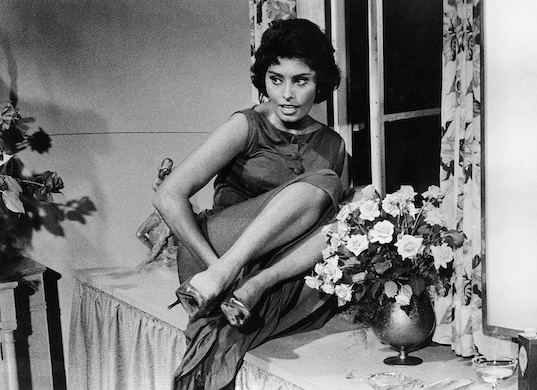With a Sophia Loren Retrospective on Tap, New Yorkers Have 13 Reasons To Get to Film at Lincoln Center
For those who don’t know, ‘Sophia Loren: La Signora di Napoli’ should show that the actress’s appeal can’t be contained within the purview of anything so mundane as human initiative.

Among the Sophia Loren films not included in “Sophia Loren: La Signora di Napoli,” a 13-film retrospective mounted by Film at Lincoln Center, is Melville Shavelson’s “Houseboat” (1958). The curatorial team responsible for this series — its members include Florence Almozini and Tyler Wilson from the host institution and their colleagues at Cinecittà, Paola Ruggiero, Camilla Cormanni, and Marco Cicala — have done well in their choices, with pictures culled from a period covering a whopping 66 years. Still, there’s a reason they didn’t pick “Houseboat.”
Even a talent as luminous as Ms. Loren can’t help but have a number of bum steers in an oeuvre adding up to a hundred movies. So, yeah, “Houseboat” isn’t great, being a sappy comedy in which our 24-year-old starlet was romantically paired with a man a good three decades older, Cary Grant. Age inappropriateness is the least of the picture’s problems, but among its virtues is “Bing! Bang! Bong!,” a transcendently inane number that Ms. Loren sings to irresistible effect. “Presto, Presto/Do your very besto.…” Spare yourself “Houseboat” and find the song online.
Was Ms. Loren the first international movie star? Film at Lincoln Center and Cinecittà qualify the claim with a neatly placed “perhaps,” but we know the drill: The actress’s appeal can’t be contained within the purview of anything so mundane as human initiative. Designated Miss Elegance at the 1950 edition of the Miss Italia beauty pageant, 15-year-old Sophia went on to attend the Centro Sperimentale di Cinematografia in Rome and started garnering bit parts as “girl kidnapped” or “Lygia’s slave” in various entertainments.
The earliest films on the docket at Film at Lincoln Center date from 1954: Mario Matolli’s “Poverty and Nobility” and Alessandro Blassetti’s “Too Bad She’s Bad.” Both are comedies and the latter is the first of 17 movies in which Ms. Loren is paired with Marcello Mastroianni.

The chemistry between the two stars is as natural as Ms. Loren’s character, Lina Stroppiani, is duplicitous. She’s a thief in a family of thieves — even nonna picks a mean pocket — and proves nettlesome to cabbie Paolo Silvestrelli (Mastroianni). There’s real joy to be had in this screwball romance, not least the silky performance by Vittorio De Sica as Lina’s father, “The Professor.” And, yes, there is a vaguely familiar song that filters through the film: “Bingo, Bango, Bongo.”
Ms. Loren won an Oscar for De Sica’s “Two Women” (1961), the first time the honor went to an actress in a foreign-language film. It’s a deceiving and, in the end, excruciating picture. Notwithstanding the context of a war-torn Italy, the story has a comedic bent — what with its colorful array of stock characters and farcical set pieces. Ms. Loren plays it to the hilt as Cesira, the headstrong and brassy mother to Rosetta (Eleanora Brown), a devout and sickly 12-year-old. Yet the story takes a dramatic turn, at which point Ms. Loren puts her star power in the service of human dignity placed under unspeakable strain.
Among the American features included are Stanley Donen’s “Arabesque” (1966), a Hitchcockian thriller co-starring Gregory Peck, and Robert Altman’s “Prêt-à-Porter” (1994), in which a 60-year-old Ms. Loren, with Mastroianni in tow, replicates the famous striptease scene from “Yesterday, Today and Tomorrow” (1963). She also essayed the title role in Charlie Chaplin’s final film, “A Countess From Hong Kong” (1967), a picture that was roundly decried upon its release, but has been undergoing some critical reappraisal.
Will it be the standout of “La Signora da Napoli?” New Yorkers will have 13 chances to find out. With Ms. Loren, those odds can’t help but pay off handsomely.

